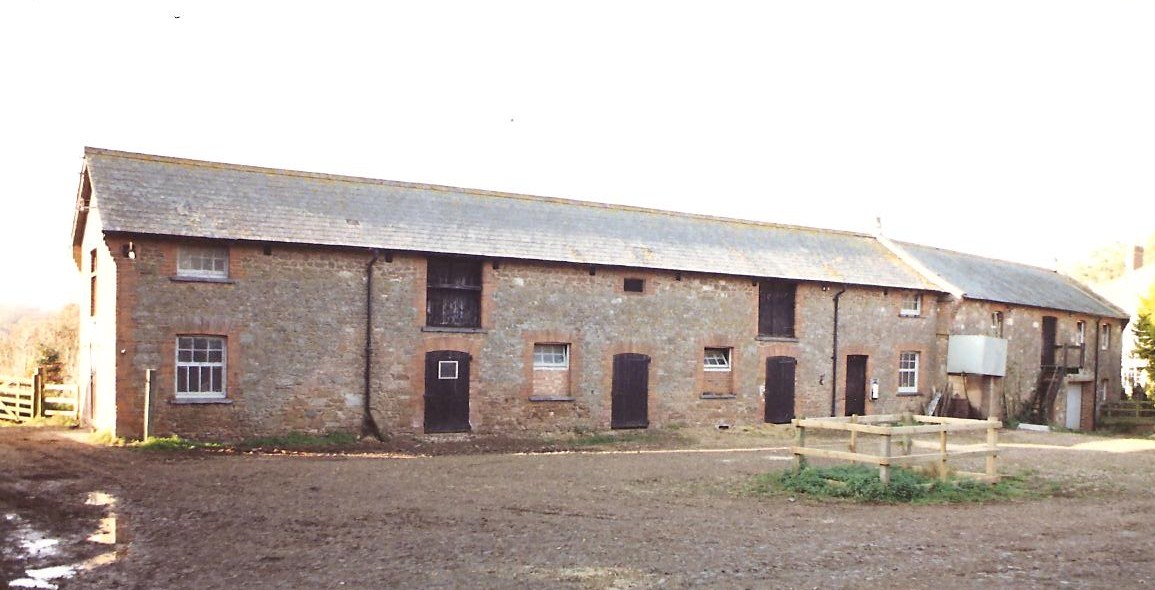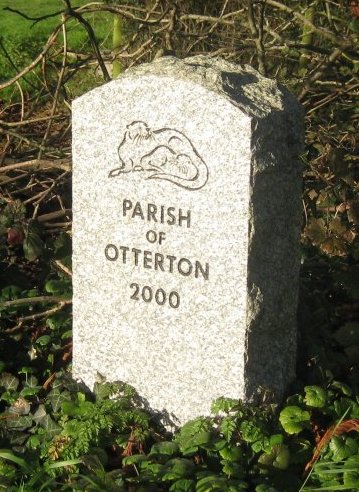The
Listed Buildings Schedule
states “Former Farmhouse,
probably monastic origins.
Early 16th, century, radically
refurbished and rearranged
circa 1850”. “The original 5
bay roof survives but the
trusses have been cut off
below collar level. They are
true cruck trusses of enormous
scantling with remains of
chamfered archbraces and
windbraces”. “ possibly house
built originally as a barn
belonging to the monastery” ie
the Priory.
From
1420 Bailiffs were appointed
annually by Syon Abbey, which
had taken over the Priory and
some Bailiffs certainly lived
elsewhere eg. John St. Clare
lived at Tidwell Manor. It has
been quoted by Michael
Harrison that Sir Peter
Courtenay was farming the
Manor in 1389. This may
suggest that this was the
Demesne Farm. After the
Reformation and Richard Duke’s
purchase of the Manor it is
possible that he was living in
the House pending the building
of the Manor House next to the
Church. The 1905 Ordnance
Survey Map names the “Manor
Farm formerly Manor House”
which indicates that farmhouse
had occasionally been used by
the Duke family.
In
January 1779 Otterton Manor
was put up for sale by
auction. An Advertisement had
appeared in Truemans Exeter
Flying Post for 4th. December
1778 stating that the “Manors
of Otterton and Little
Otterton ie. Yettington were
to be sold with their rights,
members and appurtenances,
mostly in demesne, partly by
Freehold tenants and partly by
Leasehold and Copyhold
tenants: with the healthy and
extensive Common called
Peak-Hill........and the
capital Barton and Farm called
Otterton Barton”. The Auction
Prospectus lists the land in
demesne as “Otterton House,
offices, outbuildings, yards,
gardens etc.etc......together
with rich and fertile Barton
or Farm of Otterton – 751
acres, rack value £753 per
annum.......there is upwards
of 184 acres of saltmarsh
ground belonging to the Farm
which might at a very moderate
expense be inclosed
.......There is a 2nd
saltmarsh of 30 acres
belonging to the
farm.........There is also a
valuable lime rock on this
farm which will....furnish
manure for the land...”. The
Barton is in hand and being
farmed by the Duke’s Steward.
Later in December 1779 a 14
year tenancy is being offered
in the Flying Post and John
Wood is named in occupation
with others. In 1781 Thomas
Tillman was granted a 21 year
lease at £520 pa. Earlier in
1776, 70 acres of the Barton
Farm was offered for let in
the Flying Post and the land
is described as in
“extraordinarily good
condition...fit for a dairy,
or feeding cattle...”. At the
Auction of January 1779 the
Manor sold for £90,000 but the
buyer failed to complete the
contract and it was eventually
sold to Denys Rolle for
£72,000 in 1785. Thomas
Tillman died in 1787 and his
widow managed the Farm until
1795 when her son took over.
In 1785 it is reported in the
Flying Post that “William
Hare, a boy about 16 years of
age , near 5 foot in height of
a red complexion absconded
from his master, Mr. Thomas
Tillman .......carried off
several things besides his
clothes. Whoever shall harbour
the said boy shall be punished
as the Law directs”.
Early in
1802 it was decided to divide
Otterton Barton of 751 acres,
which included 99 acres of
poor grazing land in the Otter
Estuary. 435 acres were
allocated in the south to
“South Farm” and 270 acres to
Otterton Barton Farm. They
were both rented for 14 years.
Charles Tillman was moved to
South Farm and Mrs. Mary
Bastin and her 3 sons John,
James, & William were
rented the Barton—“All that
part of the Barton – dwelling
house and offices--- with
pidgeon house, garden and
kennel garden...” By 1814 Mrs.
Bastin had died and her eldest
son John was moved to South
Farm which had been vacated by
Charles Tillman. The Barton
was put out to tender in the
Flying Post of “an exceeding
good house and other
conveniences , 10 acres
orchard, 34 of rich meadow and
235 more or less of arable and
pasture land with the use of a
lime rock and kiln adjacent
the premises”. The limekilns
location is not marked on the
1844 Tithe Map so presumably
was no longer in use. There
was a limekiln on South Farm
land in use at that time which
may have been the one
indicated in the Flying Post.
Thomas Burrows took a new
lease at the reduced rent of
£320 in 1815.
After
the end of the Napoleonic Wars
in 1815 corn prices fell
dramatically and in Britain
rents could not be paid and
many farmers were ruined. It
could be that because of this
depression in the market that
dictated the reduced rental of
the new lease for the Barton
Farm. Early in 1828, John
Staddon, Mr. Burrow’s
apprentice at the Barton, ran
away and the Flying Post
reports on the dire
consequences to anyone
harbouring or employing him.
He was the 19 year old son of
a labouring family in the
village. The 1844 Tithe Map
shows the Barton surrounded
with barns and Spreats
engraving of 1842 and Lynes
watercolour of 1833 both show
one of these. It has two
dormer hatches for hoisting
grain sacks. The Tithe Award
and 1841 Census give a clear
picture of the Barton Farm and
lands. William Burrows had
succeeded Thomas and was
living at the farmhouse with
his family ,5 servants and an
apprentice. He is farming 230
acres of arable, 18 of pasture
5 of coppice and 10 acres of
orchard. By the 1840’s farmers
are prospering. The EFP
reports‘Grain of every kind is
steadily advancing in price’.
1851 Charles Harding takes the
Barton Farm tenancy. He died
in 1867 and his wife Mary and
sons Richard and Samuel
continued running the farm.
The Land Agent, Robert
Lipscombe, wrote to Mrs.
Harding offering to reduce her
rent by £20pa ‘but not to
divulge to anyone’. In 1870
Otterton Church was rebuilt
necessitating a barn close to
the old Church being
demolished. A new barn with
the legend ‘MR 1870’ was built
to the south of the farmhouse,
with griffin statues high on
the gable ends, which are said
to have come from the old
Priory buildings. 1879 a mob
set light to ricks on Barton
farm, causing considerable
damage. The agricultural
depressions of the 1870’s do
not appear to affect S.E.Devon
due to the rapid development
of Exmouth and Budleigh
Salterton requiring an
increase in farming produce.
Improved farm machinery
required and extension to the
1870 barn and Barton Farm with
the legend “MR1887” and the
labour force increased to 8.


